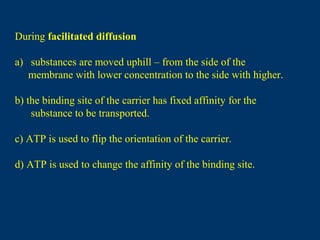
Lecture4
- 1. During facilitated diffusion a) substances are moved uphill – from the side of the membrane with lower concentration to the side with higher. b) the binding site of the carrier has fixed affinity for the substance to be transported. c) ATP is used to flip the orientation of the carrier. d) ATP is used to change the affinity of the binding site.
- 2. Lecture 4: Resting PotentialLecture 4: Resting Potential Reading: Ch 3, section: membrane potential Ch 4, section: electrical signals
- 3. Resting Membrane Potential - voltage difference across the plasma membrane, in millivolts, when the cell is at rest (i.e. no perturbing influences). Often abbreviated as Vm.
- 4. Charge separation across a membrane Vm = 0 mV Vm does not equal 0
- 5. Charge separation across a cellular membrane
- 6. How does the cell create charge separation? 1. Establishes and maintains concentration gradients for key ions (Na+ , K+ , A- ). 2. Ions diffuse through the membrane down their concentration gradients. 3. Diffusion through the membrane results in charge separation, creating a membrane potential (electrical gradient). 4. Net diffusion continues until the force exerted by the electrical gradient exactly balances the force exerted by the concentration gradient.
- 8. How does the cell create charge separation? 1. Establishes and maintains concentration gradients for key ions (Na+ , K+ , A- ). 2. Ions diffuse through the membrane down their concentration gradients. 3. Diffusion through the membrane results in charge separation, creating a membrane potential (electrical gradient). 4. Net diffusion continues until the force exerted by the electrical gradient exactly balances the force exerted by the concentration gradient.
- 9. Concentration gradient - Na+ /K+ ATPase establishes the unequal distribution of Na+ and K+ ions inside and outside of the cell ECF ICF Na+ /K+ ATPase: pumps 3 Na+ out of the cell for every 2 K+ pumped into the cell. Net movement of 1 positive charge out of the cell per cycle
- 10. Concentration gradients Macromolecular anions (A- ) - high intracellular concentration of nucleic acids and proteins which carry a net negative ionic charge. Na+ - low intracellular concentration due to the Na+ /K+ ATPase K+ - high intracellular concentration due to the Na+ /K+ ATPase Concentration (millimoles/liter) Ion extracellular intracellular relative permeability Na+ 150 15 1 K+ 5 150 50-75 A- 0 65 0 See also: Smartsite/Resources/DeBello/Animations/ion_concentration_ct.swf
- 11. ECF ICF Leak channels Permit ions to flow down concentration gradients Na/K ATPase Establishes and maintains concentration gradients
- 12. Diffusion of K+ ions through the membrane
- 13. Diffusion of Na+ ions through the membrane
- 14. Nernst equation - equation describing the equilibrium potential for a particular ion (i) Ei = RT/zF ln [i]o/[i]i = 61/z log [i]o/[i]i where R is the gas constant, T is the temperature in degrees Kelvin, z is the valence of the ionic species, and F is the Faraday constant. Thus, the equilibrium potential for K+ is: EK = 61 log (5/150) = - 90 mV the equilibrium potential for Na+ is: ENa = 61 log (150/15) = + 60 mV
- 15. How does the cell’s resting potential relate to EK and ENa? EK = -90 mV; Ena= + 60 mV; Vm = -70 mV
- 18. Graded Potentials - local changes in membrane potential that decay over short distance They result from a transient injection of current, usually the consequence of synaptic transmission and the opening of non-voltage gated ion channels (not the same as leak channels that give rise to Vm)
- 19. Graded Potentials - local changes in membrane potential that decay over short distance.
- 20. Graded Potentials – the size of the graded potential often correlates with the size of the stimulus.
- 21. Depolarization - decrease in membrane polarization to more positive values than rest. Hyperpolarization - increase in membrane polarization to more negative values than rest. Graded Potentials (cont.)
- 22. SUMMARY - Resting Potential and Graded Potentials 1. Resting Membrane Potential - Na/K pump establish and maintain concentration gradients for Na and K - diffusion thru leak channels creates charge separation - equilibrium potential proportional to concentration gradient - resting permeability of membrane for K > Na - Vm largely determined by EK 2. Neuronal Morphology 3. Graded Potentials - can be depolarizing or hyperpolarizing - can vary in size - decay with distance - rely on non-voltage gated ion channels